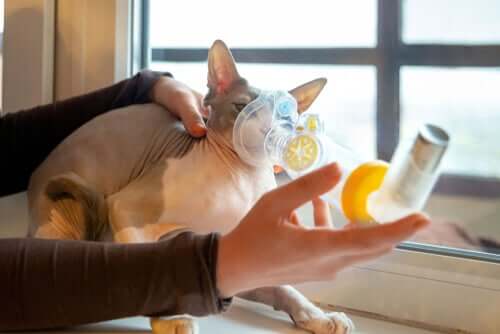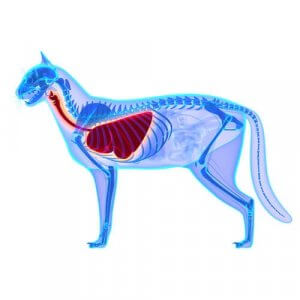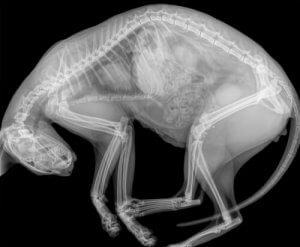Respiratory Problems in Cats: Causes and Symptoms

Respiratory problems in cats are some of the most common cases seen by emergency vet services. Symptoms can develop slowly over the course of a few days, or appear suddenly, with very few warning signs.
It’s important to understand that breathing difficulties can be really distressing for your pet, and there is a risk that their condition may deteriorate quickly, putting their life in danger.
Any animal that displays signs of respiratory distress should be treated as an emergency. Vets need to assess their condition quickly and keep them under close observation, while also providing emergency treatment and trying to find the underlying cause.
Symptoms of respiratory problems in cats
Respiratory distress or dyspnea can present in a number of different ways. The animal may suffer from a persistent cough, labored breathing, changes in vocal sounds, or reduced capacity to exercise. The most serious symptoms of respiratory problems include the following:
- As well as obvious trouble inhaling or exhaling, cats with breathing problems often show a number of other associated symptoms. For example, their breathing rate may be faster than usual.
- The animal may pant noisily with its mouth open and cough frequently. It’s also common for cats to hunch forward with their head down, as if they’re about to vomit. If they have severe breathing problems, their gums may turn blue – from lack of oxygen – and they may collapse.

Feline calicivirus and feline herpes virus are responsible for 80 – 90% of all contagious upper respiratory problems in cats.
Common causes of respiratory problems in cats
Respiratory distress can occur for a number of different reasons. Some of the most common causes include:
- Asthma: this condition causes the airways to become inflamed, causing spasms. As a result, the airways become narrower, leading to serious breathing problems.
- Pneumonia: an infection of the lungs. It may be caused by a number of different bacteria, or bronchoaspiration. Bronchoaspiration is often due to inhaling food or liquids after vomiting or regurgitation.
- Congestive cardiac insufficiency: heart failure may be the result of a build-up of liquid in and around the lungs.
- Pleural effusion: the build-up of fluid in the space around the lungs makes it hard for the chest to expand. This may be due to an infection or even some types of cancer.
- Laryngeal paralysis: this occurs when the muscles in the throat no longer function properly. This means that the larynx is unable to open to allow in enough air.
- Other causes: the presence of foreign bodies in the nasal cavity or trachea, as well as injuries to the chest wall.
This is only a small selection of the many different causes of respiratory problems in cats.

Treatment and prognosis
As you can see, respiratory problems in cats have a number of different causes, and can vary greatly in terms of severity. As such, the treatment and prognosis will also vary from case to case.
The majority of animals with breathing difficulties will benefit from being put on oxygen. You can administer oxygen therapy in a number of different ways, depending on the size of the animal and how stable they are.
In patients that are very agitated, a vet may use sedation to manage stress. If their condition is serious, and potentially fatal, they may require additional emergency treatment to help stabilize them.
Such procedures may include draining fluid from around the lungs (a thoracentesis), or creating a hole in the neck into the windpipe to allow the animal to breathe in the case of a blockage (a tracheotomy). Vets may also consider putting the animal on a ventilator to help it breathe.
Respiratory problems in cats – tests
The vet may run blood tests, take x-rays, do a CT or an ultrasound, as well as a number of other procedures that they should perform under general aesthetic, such as a bronchoscopy and bronchial washing.
All cited sources were thoroughly reviewed by our team to ensure their quality, reliability, currency, and validity. The bibliography of this article was considered reliable and of academic or scientific accuracy.
- Quimby, J., & Lappin, M. (2009). Feline focus: Update on feline upper respiratory diseases: introduction and diagnostics. Compendium (Yardley, PA), 31(12), E1-7.
- Ward, J. L., Lisciandro, G. R., Keene, B. W., Tou, S. P., & DeFrancesco, T. C. (2017). Accuracy of point-of-care lung ultrasonography for the diagnosis of cardiogenic pulmonary edema in dogs and cats with acute dyspnea. Journal of the American Veterinary Medical Association, 250(6), 666-675.
- Sleeper, M. M., Roland, R., & Drobatz, K. J. (2013). Use of the vertebral heart scale for differentiation of cardiac and noncardiac causes of respiratory distress in cats: 67 cases (2002–2003). Journal of the American Veterinary Medical Association, 242(3), 366-371.
